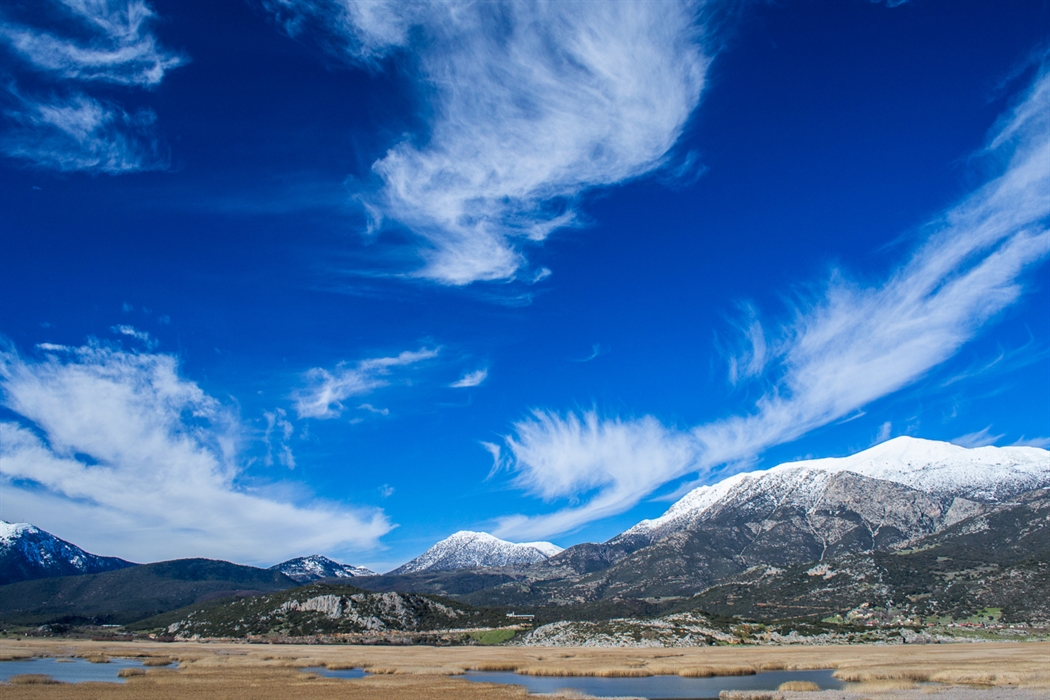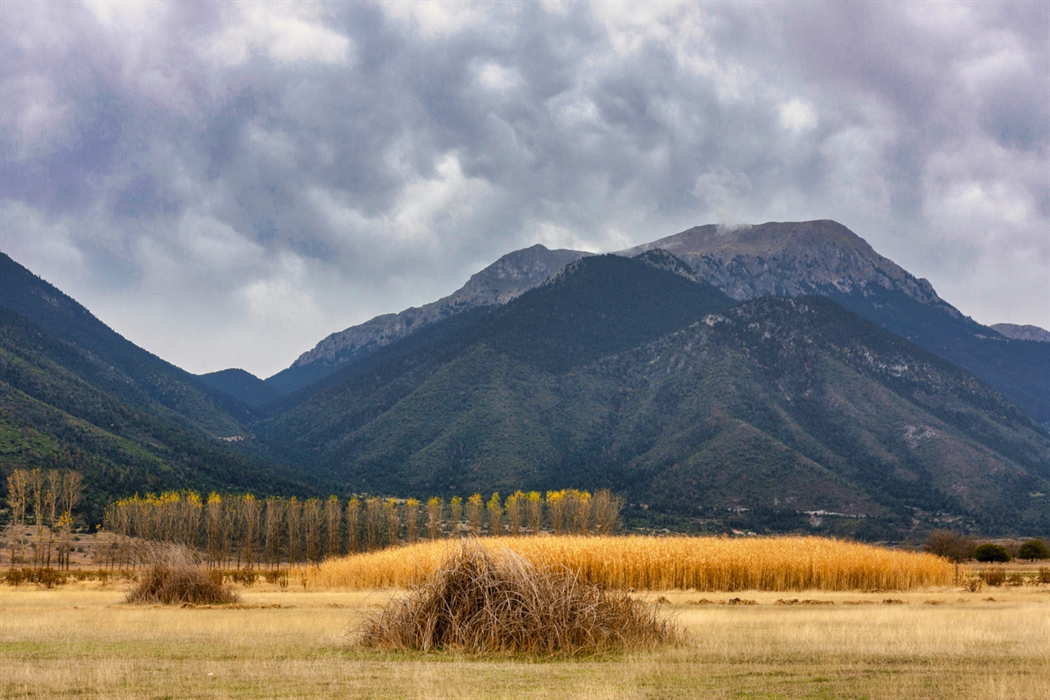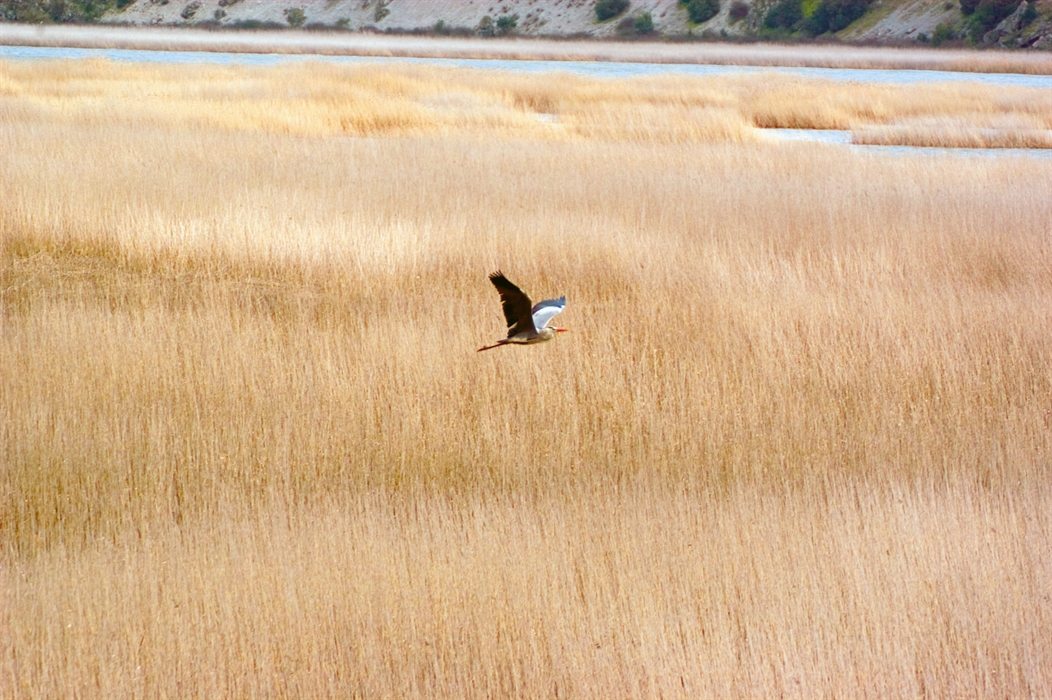The wetland of Lake Stymphalia
It is the southernmost mountain wetland of the Balkans with a wide variety of fauna. It joined the Natura 2000 network and is one of the most important wetlands in Greece.
Stymphalia is located in mountainous Corinthia at an altitude of 600m. According to mythology, the water basin between Ziria and Oligirts was the mythical nest of the Stymphalian Birds. If, in fact, if you visit the basin during the winter, when the veils of fog cover it and the reeds rise lonely through its waters, you will feel the mysterious atmosphere it exudes.
It is the southernmost mountain wetland of the Balkans with a huge variety of fauna (it hosts 160 species, mainly bird fauna). It joined the Natura 2000 network and is considered one of the most important wetlands in Greece. It is also included in the list of Important Bird Areas of Greece developed by the Hellenic Ornithological Society. It is a key stop for migratory birds such as herons, coots, great terns, black terns, night ravens, mergansers.
The rare endemic species of fish Phoxinellus stymphalicus live in its waters as well as the flounder, the smallest fish of the Balkans, which is included in the Red Book of Endangered Species.
The slopes of Oligirtos and Ziria are covered by many different types of vegetation. The area of the wetland is 3,650 hectares while the respective Natura 2000 network area is 13,000 hectares.
The tour around Stymphalia lake is like a documentary. The best route is the one that follows its eastern banks, on the road meandering in the foothills of Oligirtos and ending at the village of Lavka. From there you will have an exquisite view of the lake and the mountain of Kyllini (Zireia). It is also an ideal spot for bird watching.
If you choose the west side, which is what visitors usually do, you will drive to the foothills of Kyllini, passing the settlement of Stymfalia and Kionia enjoying the view of the lake and Oligirtos. From this route you will also reach Zarakas monastery. Then you will move towards Kastania, which is located among fir trees, at an altitude of 1000m.. Take a deep breath and you will reach the "neck" of Mavrovounii-Geronti, entering the region of Feneos with its endless plains.
See information about the Environment Museum and the Archaeological site of Stymphalia.
Did you know:
There are various organized walking paths around the lake.
Read more about the wetland at e-stymfaliia.gr
The myth of the Stymphalian birds
The mythical man-eating birds, with the bronze beaks, nails and wings, which lived hidden on the banks of Stymphalia lake, feature, along with demigod hero Hercules in his sixth labour.
The mythical man-eating birds, with the bronze beaks, nails and wings, which lived hidden on the banks of Stymphalia lake, feature, along with demigod hero Hercules in his sixth labour. The birds were a great menace to people, herds and crops. According to one version, they initially lived near Arcadian Orchomenos, from where, chased by wolves, they took refuge at Stymphalia lake. Hercules didn’t know how to make them come out of the marsh, and that’s when goddess Athena helped him giving him a bronze rattle, forged in Hephaestus’ workshop. Shaking the rattle on a hill by the lake, Hercules scared the birds, which came out of their nests terrified. Thus, he managed to eliminate most of them with his arrows. In order to show gratitude, Hercules offered some of the killed birds to Athena.
According to a comment of Pausanias, in his time, there were birds known as Stymphalian birds in Arabia, a name indicative of Hercules’ fame -as a historical figure now-, and the prominent place of the Greek element among barbarians. The birds were as big as cranes and looked like ibis (Ciconiiformes) -although their beaks were more straight and stronger. They were as dangerous as lions and leopards, since they pounced on hunters and were able to pierce bronze and iron protective equipment with their beaks. In order to catch them, they finally forged an armour of cork, that trapped their beaks.
Source: Mythological Atlas of Greece, Pedro Olalla/Road Publishers.
The trials of Hercules
The famous hero, descendant of Perseus, had both supernatural abilities and human weaknesses. He was born in Thebes to Amphitryon and Alcmene, but his true father was Zeus. In a fit of madness, sent by goddess Hera, he killed his children with Megara. When he came round, he wanted to commit suicide, but he eventually decided to consult the Oracle of Delphi. According to Pythia’s oracle, he had to go to Argos to serve for 12 years his cousin, king Eurystheus. By order of Eurystheus, he had to perform the labours which would grant him immortality and his entrance to Olympus.
Hercules probably emerges as a historical figure a bit earlier than mid-13th century B C.
Location
Find the destination on the interactive map below.
Categories
Weather
Σχετικό περιεχόμενο χρηστών (UGC)
Ενημερωθείτε για ενδιαφέροντα θέματα γύρω από τον προορισμό μέσα από το περιεχόμενο των χρηστών μας
Discover 7 hidden gems of the Peloponnese
Many of you may have already visited some of the most renowned attractions…
TOP 10 archaeological museums in the Peloponnese
Olympia, Mycenae, Epidaurus, Diros Cave, Ancient Corinth, Messene and…
TOP 10 Castles in the Peloponnese
Castles galore! Mystras, Monemvasia, Palamidi, Methoni, Koroni,…
Newsletters
- About us
- FAQ's
- Map
- Tourism information centers
- Disclaimer
- Sitemap
- Our brand
- Media roum
- Adding your bussiness
- Corporate
- MICE

Peloponnese. Greece beyond the obvious





Design and creation from Cosmote
Marinas and Moorings
Diving centers
Get inspired
- Media gallery
- Blog
- The Peloponnese in the media
- Your feedback
- Users' general content
- Users' local products
- Users' events content
- Ask a local
More
- Accommodation
- Travel agencies
- Restaurants
- Services
- Destinations Map
- Weather
- Public transport
- Events
- Frequently asked questions
- Useful phones
- B2B
- Destination Data
- Contact




